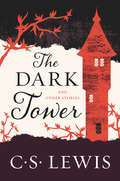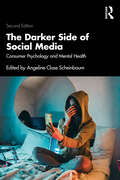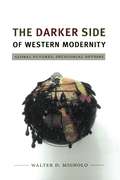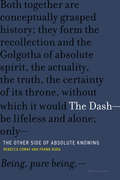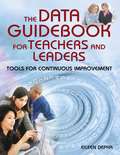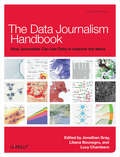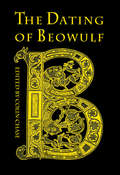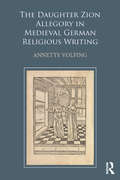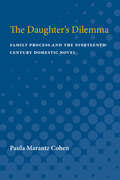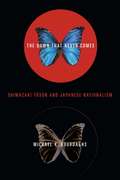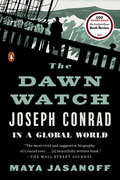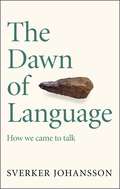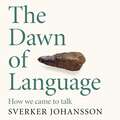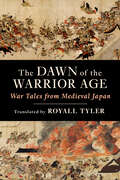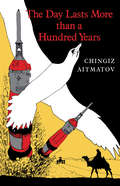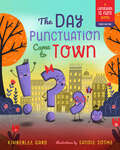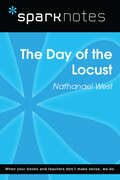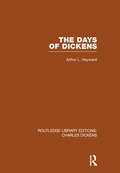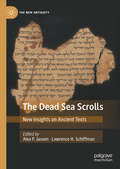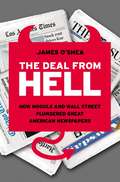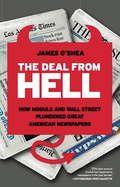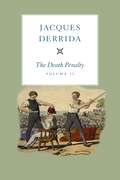- Table View
- List View
The Dark Tower: And Other Stories
by C. S. LewisA repackaged edition of the revered author’s definitive collection of short fiction, which explores enduring spiritual and science fiction themes such as space, time, reality, fantasy, God, and the fate of humankind.From C.S. Lewis—the great British writer, scholar, lay theologian, broadcaster, Christian apologist, and author of Mere Christianity, The Screwtape Letters, The Great Divorce, The Chronicles of Narnia, and many other beloved classics—comes a collection of his dazzling short fiction.This collection of futuristic fiction includes a breathtaking science fiction story written early in his career in which Cambridge intellectuals witness the breach of space-time through a chronoscope—a telescope that looks not just into another world, but into another time. As powerful, inventive, and profound as his theological and philosophical works, The Dark Tower reveals another side of Lewis’s creative mind and his longtime fascination with reality and spirituality. It is ideal reading for fans of J. R. R. Tolkien, Lewis’s longtime friend and colleague.
The Darker Side of Social Media: Consumer Psychology and Mental Health
by Angeline Close ScheinbaumThe Darker Side of Social Media: Consumer Psychology and Mental Health takes a research-based, scientific approach to examining problematic issues and outcomes that are related to social media use by consumers. Now in its second edition, it relies on psychological theories to help explain or predict problematic online behavior within the social media landscape through the lens of mental health.With an aim to provide solutions, the authors spotlight the key issues affecting consumer well-being and mental health due to the omnipresence and overuse of social media. The book dissects the unintended consequences of too much social media use, specifying key problems like disconnection anxiety, eating disorders, online fraud, cyberbullying, the dark web, addiction, depression, self-discrepancies, and serious privacy concerns (especially impacting children or young people). The book provides grapples with mental health disorders such as anxiety, depression, self-harm, and eating disorders that can be intensified by, or correlated with, too much social media use. The authors meticulously review the various facets of the darker side of online presence and propose actionable solutions for each of the problems stated, providing scholars with a conceptual model with propositions for continued research.This international exploration of social media is a must-read for students of marketing, advertising, and public relations, as well as scholars/managers of business, marketing, psychology, communication, management, and sociology. It will also be of interest to social media users, those navigating new media platforms parents, policymakers, and practitioners.
The Darker Side of Western Modernity: Global Futures, Decolonial Options
by Walter D. MignoloDuring the Renaissance and the Enlightenment, coloniality emerged as a new structure of power as Europeans colonized the Americas and built on the ideas of Western civilization and modernity as the endpoints of historical time and Europe as the center of the world. Walter D. Mignolo argues that coloniality is the darker side of Western modernity, a complex matrix of power that has been created and controlled by Western men and institutions from the Renaissance, when it was driven by Christian theology, through the late twentieth century and the dictates of neoliberalism. This cycle of coloniality is coming to an end. Two main forces are challenging Western leadership in the early twenty-first century. One of these, "dewesternization," is an irreversible shift to the East in struggles over knowledge, economics, and politics. The second force is "decoloniality." Mignolo explains that decoloniality requires delinking from the colonial matrix of power underlying Western modernity to imagine and build global futures in which human beings and the natural world are no longer exploited in the relentless quest for wealth accumulation.
The Dash: The Other Side of Absolute Knowing (Short Circuits)
by Rebecca Comay Frank RudaAn argument that what is usually dismissed as the “mystical shell” of Hegel's thought—the concept of absolute knowledge—is actually its most “rational kernel.” This book sets out from a counterintuitive premise: the “mystical shell” of Hegel's system proves to be its most “rational kernel.” Hegel's radicalism is located precisely at the point where his thought seems to regress most. Most current readings try to update Hegel's thought by pruning back his grandiose claims to “absolute knowing.” Comay and Ruda invert this deflationary gesture by inflating what seems to be most trivial: the absolute is grasped only in the minutiae of its most mundane appearances. Reading Hegel without presupposition, without eliminating anything in advance or making any decision about what is essential and what is inessential, what is living and what is dead, they explore his presentation of the absolute to the letter.The Dash is organized around a pair of seemingly innocuous details. Hegel punctuates strangely. He ends the Phenomenology of Spirit with a dash, and he begins the Science of Logic with a dash. This distinctive punctuation reveals an ambiguity at the heart of absolute knowing. The dash combines hesitation and acceleration. Its orientation is simultaneously retrospective and prospective. It both holds back and propels. It severs and connects. It demurs and insists. It interrupts and prolongs. It generates nonsequiturs and produces explanations. It leads in all directions: continuation, deviation, meaningless termination. This challenges every cliché about the Hegelian dialectic as a machine of uninterrupted teleological progress. The dialectical movement is, rather, structured by intermittency, interruption, hesitation, blockage, abruption, and random, unpredictable change—a rhythm that displays all the vicissitudes of the Freudian drive.
The Data Guidebook for Teachers and Leaders: Tools for Continuous Improvement
by Eileen DepkaAre you looking for new ways to use data in the decision-making process? Are you seeking tools that provide better flow-through from data to improved student achievement? Have you ever considered including students in the data-to-improvement cycle? Schools recognize that data is an essential decision-making tool, but it requires teamwork and reflection to reap the maximum benefits. This guidebook offers practical collection and analysis methods and templates as well as tips for building trust and working together.
The Data Journalism Handbook: How Journalists Can Use Data to Improve the News
by Jonathan Gray Lucy Chambers Liliana BounegruWhen you combine the sheer scale and range of digital information now available with a journalist’s "nose for news" and her ability to tell a compelling story, a new world of possibility opens up. With The Data Journalism Handbook, you’ll explore the potential, limits, and applied uses of this new and fascinating field.This valuable handbook has attracted scores of contributors since the European Journalism Centre and the Open Knowledge Foundation launched the project at MozFest 2011. Through a collection of tips and techniques from leading journalists, professors, software developers, and data analysts, you’ll learn how data can be either the source of data journalism or a tool with which the story is told—or both.Examine the use of data journalism at the BBC, the Chicago Tribune, the Guardian, and other news organizationsExplore in-depth case studies on elections, riots, school performance, and corruptionLearn how to find data from the Web, through freedom of information laws, and by "crowd sourcing"Extract information from raw data with tips for working with numbers and statistics and using data visualizationDeliver data through infographics, news apps, open data platforms, and download links
The Dating of Beowulf
by Colin ChaseThe date of Beowulf, debated for almost a century, is a small question with large consequences. Does the poem provide us with an accurate if idealized view of early Germanic culture? Or is it rather a creature of nostalgia and imagination, born of the desire of a later age to create for itself a glorious past? If we cannot decide when, between the 5th and 11th centuries, the poem was composed, we cannot distinguish what elements in Beowulf belong properly to the history of material culture, to the history of myth and legend, to political history, or to the development of the English literary imagination.This book represents both individual and concerted attempts to deal with this important question, and presents one of the most important inconclusions in the study of Old English. The contributors raise so many doubts, turn up so much new and disturbing information, dismantle so many long-accepted scholarly constructs that Beowulf studies will never be the same: henceforth every discussion of the poem and its period will begin with reference to this volume.
The Daughter Zion Allegory in Medieval German Religious Writing
by Annette VolfingThe Daughter Zion allegory represents a particular narrative articulation of the paradigm of bridal mysticism deriving from the Song of Songs, the core element of which is the quest of Daughter Zion for a worthy object of love. Examining medieval German religious writing (verse and prose) and Dutch prose works, Annette Volfing shows that this storyline provides an excellent springboard for investigating key aspects of medieval religious and literary culture. In particular, she argues, the allegory lends itself to an exploration of the medieval sense of self; of the scope of human agency within the mystical encounter; of the gendering of the religious subject; of conceptions of space and enclosure; and of fantasies of violence and aggression. Volfing suggests that Daughter Zion adaptations increasingly tended to empower the religious subject to seek a more immediate relationship with the divine and to embrace a wider range of emotions: the mediating personifications are gradually eliminated in favour of a model of religious experience in which the human subject engages directly with Christ. Overall, the development of the allegory from the twelfth to the fifteenth centuries marks the striving towards a greater sense of equality and affective reciprocity with the divine, within the context of an erotic union.
The Daughter's Dilemma: Family Process and the Nineteenth-Century Domestic Novel
by Paula Marantz CohenThe Daughter's Dilemma breaks new ground in literary studies through its application of family systems theory to the analysis of nineteenth-century domestic novels. Cohen argues for structural correspondences between families and novels: as systems seeking closure, they are governed by certain analogous laws. She argues further that the father-daughter dyad is the pivotal structure by which the nuclear family and the domestic novel were able to define themselves as closed systems. The study treats novels by Samuel Richardson, Jane Austen. Emily Bronte, George Eliot, and Henry James and places them in the context of the writers' individual family experiences. Drawing on recent work in literary and feminist criticism, anthropology, history, and psychoanalysis. as well as family systems theory, Cohen seeks to critique the limitations of these theoretical models even as she employs them lo illuminate the texts under discussion. The study's approach leads to insights about the contemporary family and about the present state of literature and literary criticism. Cohen concludes by suggesting that the modern period marked the demise of an ideology favoring closed systems. The result has been both a nostalgia for those systems and a redefinition of experience and relationship as open and subject to endless interpretation. Such an ideological reformulation helps explain the present insistence by literary theorists on the inescapability of the text and the "reality" of representation.
The Dawn That Never Comes: Shimazaki T son and Japanese Nationalism
by Michael BourdaghsA critical rethinking of theories of national imagination, The Dawn That Never Comes offers the most detailed reading to date in English of one of modern Japan's most influential poets and novelists. This book surveys the ideologies of national imagination at play in early-twentieth-century Japan, specifically in the work of Shimazaki Toson (1872-1943). Bourdaghs analyzes Toson's major works in detail, using them to demonstrate that the field of national imagination requires a complex interweaving of varied--and sometimes even contradictory--figures for imagining the national community.
The Dawn That Never Comes: Shimazaki Toson and Japanese Nationalism (Studies of the Weatherhead East Asian Institute, Columbia University)
by Michael BourdaghsA critical rethinking of theories of national imagination, The Dawn That Never Comes offers the most detailed reading to date in English of one of modern Japan's most influential poets and novelists, Shimazaki Toson (1872–1943). It also reveals how Toson's works influenced the production of a fluid, shifting form of national imagination that has characterized twentieth-century Japan. Analyzing Toson's major works, Michael K. Bourdaghs demonstrates that the construction of national imagination requires a complex interweaving of varied—and sometimes contradictory—figures for imagining the national community. Many scholars have shown, for example, that modern hygiene has functioned in nationalist thought as a method of excluding foreign others as diseased. This study explores the multiple images of illness appearing in Toson's fiction to demonstrate that hygiene employs more than one model of pathology, and it reveals how this multiplicity functioned to produce the combinations of exclusion and assimilation required to sustain a sense of national community. Others have argued that nationalism is inherently ambivalent and self-contradictory; Bourdaghs shows more concretely both how this is so and why it is necessary and provides, in the process, a new way of thinking about national imagination. Individual chapters take up such issues as modern medicine and the discourses of national health; ideologies of the family and its representation in modern literary works; the gendering of the canon of national literature; and the multiple forms of space and time that narratives of national history require.
The Dawn Watch: Joseph Conrad in a Global World
by Maya Jasanoff“Enlightening, compassionate, superb” —John Le CarréA visionary exploration of the life and times of Joseph Conrad, his turbulent age of globalization and our own, from one of the most exciting young historians writing todayMigration, terrorism, the tensions between global capitalism and nationalism, and a communications revolution: these forces shaped Joseph Conrad’s destiny at the dawn of the twentieth century. In this brilliant new interpretation of one of the great voices in modern literature, Maya Jasanoff reveals Conrad as a prophet of globalization. As an immigrant from Poland to England, and in travels from Malaya to Congo to the Caribbean, Conrad navigated an interconnected world, and captured it in a literary oeuvre of extraordinary depth. His life story delivers a history of globalization from the inside out, and reflects powerfully on the aspirations and challenges of the modern world. Joseph Conrad was born Józef Teodor Konrad Korzeniowski in 1857, to Polish parents in the Russian Empire. At sixteen he left the landlocked heart of Europe to become a sailor, and for the next twenty years travelled the world’s oceans before settling permanently in England as an author. He saw the surging, competitive "new imperialism" that planted a flag in almost every populated part of the globe. He got a close look, too, at the places “beyond the end of telegraph cables and mail-boat lines,” and the hypocrisy of the west’s most cherished ideals. In a compelling blend of history, biography, and travelogue, Maya Jasanoff follows Conrad’s routes and the stories of his four greatest works—The Secret Agent, Lord Jim, Heart of Darkness, and Nostromo. Genre-bending, intellectually thrilling, and deeply humane, The Dawn Watch embarks on a spell-binding expedition into the dark heart of Conrad’s world—and through it to our own.
The Dawn of Language: The story of how we came to talk
by Sverker Johansson"A model of popular-science writing" STEVEN POOLEWho was "the first speaker" and what was their first message?An erudite, tightly woven and beautifully written account of one of humanity's greatest mysteries - the origins of language.Drawing on evidence from many fields, including archaeology, anthropology, neurology and linguistics, Sverker Johansson weaves these disparate threads together to show how our human ancestors evolved into language users. The Dawn of Language provides a fascinating survey of how grammar came into being and the differences or similarities between languages spoken around the world, before exploring how language eventually emerged in the very remote human past.Our intellectual and physiological changes through the process of evolution both have a bearing on our ability to acquire language. But to what extent is the evolution of language dependent on genes, or on environment? How has language evolved further, and how is it changing now, in the process of globalisation? And which aspects of language ensure that robots are not yet intelligent enough to reconstruct how language has evolved? Johansson's far-reaching, authoritative and research-based approach to language is brought to life through dozens of astonishing examples, both human and animal, in a fascinatingly erudite and entertaining volume for anyone who has ever contemplated not just why we speak the way we do, but why we speak at all.Translated from the Swedish by Frank Perry
The Dawn of Language: The story of how we came to talk
by Sverker JohanssonAn erudite, tightly woven and beautifully written account of one of humanity's greatest mysteries - the origins of language.Who was "the first speaker" and what was their first message?Drawing on evidence from many fields, including archaeology, anthropology, neurology and linguistics, Sverker Johansson weaves these disparate threads together to show how our human ancestors evolved into language users. The Dawn of Language provides a fascinating survey of how grammar came into being and the differences or similarities between languages spoken around the world, before exploring how language eventually emerged in the very remote human past.Our intellectual and physiological changes through the process of evolution both have a bearing on our ability to acquire language. But to what extent is the evolution of language dependent on genes, or on environment? How has language evolved further, and how is it changing now, in the process of globalisation? And which aspects of language ensure that robots are not yet intelligent enough to reconstruct how language has evolved? Johansson's far-reaching, authoritative and research-based approach to language is brought to life through dozens of astonishing examples, both human and animal, in a fascinatingly erudite and entertaining volume for anyone who has ever contemplated not just why we speak the way we do, but why we speak at all.Sverker Johansson's claim to fame otherwise is to have invented the LSJBot, which has written 8% of all articles on Swedish Wikipedia. He is also a physicist, has conducted research at CERN and participated in EVOLANG, a leading international research conference on language.TRANSLATED FROM THE SWEDISH BY FRANK PERRY(P) 2021 Quercus Editions Limited
The Dawn of Language: The story of how we came to talk
by Sverker Johansson"A model of popular-science writing" STEVEN POOLEWho was "the first speaker" and what was their first message?An erudite, tightly woven and beautifully written account of one of humanity's greatest mysteries - the origins of language.Drawing on evidence from many fields, including archaeology, anthropology, neurology and linguistics, Sverker Johansson weaves these disparate threads together to show how our human ancestors evolved into language users. The Dawn of Language provides a fascinating survey of how grammar came into being and the differences or similarities between languages spoken around the world, before exploring how language eventually emerged in the very remote human past.Our intellectual and physiological changes through the process of evolution both have a bearing on our ability to acquire language. But to what extent is the evolution of language dependent on genes, or on environment? How has language evolved further, and how is it changing now, in the process of globalisation? And which aspects of language ensure that robots are not yet intelligent enough to reconstruct how language has evolved? Johansson's far-reaching, authoritative and research-based approach to language is brought to life through dozens of astonishing examples, both human and animal, in a fascinatingly erudite and entertaining volume for anyone who has ever contemplated not just why we speak the way we do, but why we speak at all.Translated from the Swedish by Frank Perry
The Dawn of the Warrior Age: War Tales from Medieval Japan
by Royall TylerThe war between the Heike and Genji clans in the twelfth and thirteenth centuries is among the most compelling and significant moments in Japan’s history, immortalized in The Tale of the Heike. Beyond the events recorded in this canonical text, the conflicts of the surrounding years are crucial to medieval Japanese culture and history. In 1156, power began to slip away from the court nobility in Kyoto. A shogunate was later founded in Kamakura, and in 1221, it won a decisive victory over the court.The three war tales translated in this book tell the story of these critical decades, vividly recording stages in the passage from rule by the imperial court in Kyoto to rule by the warrior government in Kamakura. “The Tale of the Hōgen Years” recounts a deposed emperor’s disastrous attempt to regain the throne in 1156. “The Tale of the Heiji Years” narrates a bloody clash between rival courtier factions in 1159. “An Account of the Jōkyū Years” records Kamakura’s victory over the imperial attempt to overthrow it in 1221. These works do not simply complete the story of The Tale of the Heike—they are classics of Japanese literature in their own right. Royall Tyler’s lively translation masterfully conveys the nature of medieval Japanese warfare, rendering aristocratic power politics and the brutal realities of violence with equal aplomb. The Dawn of the Warrior Age is an essential book for readers interested in premodern Japanese history and literature.
The Day Lasts More than a Hundred Years
by Chingiz Aitmatov" . . . a rewarding book." —Times Literary SupplementSet in the vast windswept Central Asian steppes and the infinite reaches of galactic space, this powerful novel offers a vivid view of the culture and values of the Soviet Union's Central Asian peoples.
The Day Punctuation Came to Town (Language Is Fun! Ser. #2)
by Kimberlee GardRunner-up for the Reading the West Book Awards
The Day Without Yesterday
by William RossbachBranch Nichols, adventurer, mystery writer, and eternal skeptic, must travel the globe to acquire nine parts to a pyramid, each being safeguarded by members of a 4000-year-old secret organization known as the Pyramidions. When assembled, the pyramid becomes a key. But what does is unlock, and what would it mean for mankind? He makes the journey with his lifelong friend, Roddy, and a pesky female archeology writer, Linda, while being relentlessly pursued by assassins. Questions abound: why was the pyramid of Giza built; how was it built; who was ultimately behind its construction? And what “secret” world power has the most to lose if they complete their quest? Truth—scientific, political, and historical—meets with exotic adventure as the three have their understanding of the world, and how it works, shattered and reformed with each new mind-boggling revelation. The past isn’t what it used to be.
The Day of the Locust (SparkNotes Literature Guide Series)
by SparkNotesThe Day of the Locust (SparkNotes Literature Guide) by Nathanael West Making the reading experience fun! Created by Harvard students for students everywhere, SparkNotes is a new breed of study guide: smarter, better, faster. Geared to what today's students need to know, SparkNotes provides chapter-by-chapter analysis; explanations of key themes, motifs, and symbols; and a review quiz and essay topics. Lively and accessible, these guides are perfect for late-night studying and writing papers.
The Days of Dickens: A Glance at Some Aspects of Early Victorian Life in London (Routledge Library Editions: Charles Dickens)
by Arthur L. HaywardThese chapters deal with the life of London from the early 1830’s to the mid-1860’s. The book mainly focuses on the social life of the day, but also deals with the blacker side of London and travel and country life.
The Dead Sea Scrolls: New Insights on Ancient Texts (The New Antiquity)
by Lawrence H. Schiffman Alex P. JassenThis volume draws readers into the exciting world of the Dead Sea Scrolls – around 930 manuscripts which were discovered in caves near the ancient settlement of Qumran between 1947 and 1956, and which transformed scholarship of the Bible, Judaism and Christianity. Ten scholars working at the forefront of their field address big-picture issues in relation to the scroll fragments, including their preservation and conservation; their availability electronically; and their relation to Rabbinic literature. The book also looks at the archaeology of Qumran, and the history and identity of the community; ancient writing systems; the scrolls in relation to the wider world of the time – the practice of magic and demonology, prayer, and colonial violence and power – as well as representations of them in popular media. The volume situates Dead Sea Scrolls scholarship within broader conversations in the study of the ancient world: Biblical Studies, Religious Studies, Classics, Archaeology, Jewish Studies, and Ancient History.
The Deal from Hell
by James O'SheaIn 2000, after the Tribune Company acquired Times Mirror Corporation, it comprised the most powerful collection of newspapers in the world. How then did Tribune nosedive into bankruptcy and public scandal? <P><P>In The Deal From Hell, veteran Tribune and Los Angeles Times editor James O'Shea takes us behind the scenes of the decisions that led to disaster in boardrooms and newsrooms from coast to coast, based on access to key players, court testimony, and sworn depositions. The Deal From Hell is a riveting narrative that chronicles how news industry executives and editors--convinced they were acting in the best interests of their publications--made a series of flawed decisions that endangered journalistic credibility and drove the newspapers, already confronting a perfect storm of political, technological, economic, and social turmoil, to the brink of extinction.
The Deal from Hell: How Moguls and Wall Street Plundered Great American Newspapers
by James O'SheaIn 2000, after the Tribune Company acquired Times Mirror Corporation, it comprised the most powerful collection of newspapers in the world. How then did Tribune nosedive into bankruptcy and public scandal? In The Deal From Hell, veteran Tribune and Los Angeles Times editor James O'Shea takes us behind the scenes of the decisions that led to disaster in boardrooms and newsrooms from coast to coast, based on access to key players, court testimony, and sworn depositions.The Deal From Hell is a riveting narrative that chronicles how news industry executives and editors--convinced they were acting in the best interests of their publications--made a series of flawed decisions that endangered journalistic credibility and drove the newspapers, already confronting a perfect storm of political, technological, economic, and social turmoil, to the brink of extinction.
The Death Penalty, Volume II
by Jacques Derrida Elizabeth RottenbergIn the first volume of his extraordinary analysis of the death penalty, Jacques Derrida began a journey toward an ambitious end: the first truly philosophical argument against the death penalty. Exploring an impressive breadth of thought, he traced a deeply entrenched logic throughout the whole of Western philosophy that has justified the state’s right to take a life. He also marked literature as a crucial place where this logic has been most effectively challenged. In this second and final volume, Derrida builds on these analyses toward a definitive argument against capital punishment. Of central importance in this second volume is Kant’s explicit justification of the death penalty in the Metaphysics of Morals. Thoroughly deconstructing Kant’s position—which holds the death penalty as exemplary of the eye-for-an-eye Talionic law—Derrida exposes numerous damning contradictions and exceptions. Keeping the current death penalty in the United States in view, he further explores the “anesthesial logic” he analyzed in volume one, addressing the themes of cruelty and pain through texts by Robespierre and Freud, reading Heidegger, and—in a fascinating, improvised final session—the nineteenth-century Spanish Catholic thinker Donoso Cortés. Ultimately, Derrida shows that the rationality of the death penalty as represented by Kant involves an imposition of knowledge and calculability on a fundamental condition of non-knowledge—that we don’t otherwise know what or when our deaths will be. In this way, the death penalty acts out a phantasm of mastery over one’s own death. Derrida’s thoughts arrive at a particular moment in history: when the death penalty in the United States is the closest it has ever been to abolition, and yet when the arguments on all sides are as confused as ever. His powerful analysis will prove to be a paramount contribution to this debate as well as a lasting entry in his celebrated oeuvre.
